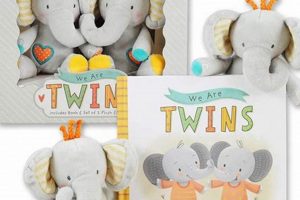Gifts of monetary value or assets intended for an infant’s future financial well-being represent a growing trend in modern gift-giving. These offerings can take diverse forms, including savings accounts, educational funds, stocks, bonds, or contributions to existing investment portfolios held in trust for the child. A practical instance is the establishment of a 529 plan seeded with initial contributions at the time of the baby’s birth.
The significance of providing such early financial support lies in its potential to compound over time, providing substantial resources for future expenses like education, housing, or even entrepreneurial endeavors. Historically, gifting practices centered on tangible items. However, a shift towards long-term investment reflects an increased awareness of the rising costs associated with higher education and the benefits of early financial planning.
Given the increasing popularity and multifaceted nature of this trend, subsequent sections will explore various suitable vehicles for these contributions, along with considerations for tax implications, custodial account management, and strategies for responsible gifting that maximize long-term benefits for the recipient.
Guidance on Monetary Presents for Infants
The following provides recommendations for those considering contributing toward an infant’s future financial security through gifts of value. Careful planning ensures the most effective and responsible conveyance of these resources.
Tip 1: Initiate a 529 Education Savings Plan. These plans offer tax advantages for educational expenses and allow contributions from multiple sources. Research state-specific plans for potential tax benefits.
Tip 2: Open a Custodial Brokerage Account. This account, held in trust for the child, allows investment in stocks, bonds, and mutual funds. Understand the Uniform Transfers to Minors Act (UTMA) or Uniform Gifts to Minors Act (UGMA) regulations applicable in the relevant jurisdiction.
Tip 3: Consider a High-Yield Savings Account. Though generally offering lower returns than investment accounts, these provide a safe and liquid option for early savings. Compare interest rates across institutions.
Tip 4: Purchase U.S. Savings Bonds. Series EE and Series I bonds offer fixed or inflation-adjusted returns and can be redeemed tax-free for educational expenses when specific requirements are met.
Tip 5: Contribute to a Roth IRA (if applicable). While uncommon, if the infant has earned income (e.g., from child modeling), contributions to a Roth IRA can offer significant long-term tax advantages.
Tip 6: Establish a Trust Fund. For substantial assets or specific control over distribution, a trust fund provides a legal framework for managing and disbursing funds according to predetermined terms.
Tip 7: Coordinate with the Parents. Discuss gift plans with the child’s parents to avoid duplication, ensure alignment with their financial goals, and understand existing savings strategies.
Implementing these guidelines aids in maximizing the potential of early contributions, fostering financial stability for the child’s future.
The subsequent section will address the long-term implications of providing funds for infants and the ethics of responsible gift-giving in this context.
1. Long-Term Growth
The potential for significant accrual over extended durations is intrinsically linked to providing monetary gifts early in a child’s life. The fundamental principle of compounding interest allows even modest initial investments to appreciate substantially over the years, provided the funds are allocated strategically and maintained consistently. This effect stems from the reinvestment of earnings, which generates further earnings, thus creating an accelerating growth trajectory. For example, an initial contribution to a tax-advantaged education savings account at birth can, through prudent investment and consistent contributions, potentially cover a significant portion of future tuition costs. This underscores the practical advantage of initiating financial planning for an infant.
The selection of appropriate investment vehicles directly influences the realization of favorable long-term growth. Asset allocation strategies that incorporate a diversified portfolio encompassing stocks, bonds, and potentially real estate offer the prospect of balancing risk and return. Furthermore, the time horizon associated with early childhood investments affords the opportunity to weather market fluctuations, provided a long-term perspective is maintained. Practical applications extend to establishing custodial brokerage accounts, contributing to retirement savings vehicles in the child’s name (if earned income exists), or strategically purchasing appreciating assets. The key is to prioritize investments with the capacity for substantial growth over the long term, bearing in mind the child’s future financial objectives.
In summary, the relationship between early monetary gifts and long-term growth is pivotal. Careful consideration of investment vehicles, consistent contributions, and a long-term investment horizon are crucial. The challenge lies in balancing risk and return, while also educating the child, as they mature, about the principles of sound financial management. Ultimately, these early contributions can serve as a foundation for future financial security and independence, provided they are managed responsibly and aligned with long-term financial goals.
2. Tax Implications
The transfer of monetary assets to an infant, while intended to provide future financial security, is subject to various tax regulations. Understanding these rules is essential for both the gift giver and the recipient’s custodians to ensure compliance and maximize the long-term benefits of the gift.
- Gift Tax
The United States levies a gift tax on transfers of property to others without receiving full consideration in return. The annual gift tax exclusion permits individuals to gift a certain amount per recipient each year without incurring gift tax liability. Amounts exceeding this annual exclusion may reduce the giver’s lifetime gift and estate tax exemption. For substantial transfers, consulting a tax professional is advisable.
- Income Tax
Depending on the type of asset gifted, income tax implications may arise. For example, interest earned in a savings account or dividends received from stocks held in a custodial account are generally taxable to the child. The “kiddie tax” rules apply to unearned income of children, potentially taxing such income at the parents’ higher marginal tax rate under certain circumstances. Proper planning can mitigate adverse income tax consequences.
- Estate Tax
The estate tax affects the transfer of assets upon death. While the estate tax exemption is currently substantial, it is subject to change. Gifts made during the giver’s lifetime can reduce the value of their taxable estate, potentially minimizing future estate tax liabilities. However, certain types of gifts, such as those made within three years of death, may be included in the estate for tax purposes.
- 529 Plans
Contributions to 529 education savings plans may qualify for state income tax deductions or credits, depending on the state’s specific regulations. Earnings within the 529 plan grow tax-deferred, and withdrawals for qualified education expenses are tax-free at the federal level. This tax-advantaged structure makes 529 plans a popular option for funding future education costs.
These tax considerations are paramount when providing monetary gifts for infants. Understanding the gift tax, income tax, estate tax, and benefits of vehicles like 529 plans enables informed decision-making. Such awareness ensures that the gift benefits the child as intended, without creating unforeseen tax liabilities or complications. Prudent planning, ideally with professional guidance, is crucial to navigating the intricate tax landscape surrounding early financial gifts.
3. Custodial Management
The administration of financial assets bestowed upon a minor necessitates a responsible custodial framework. This framework governs the legal and ethical obligations associated with managing these assets until the child reaches the age of majority, thereby ensuring their appropriate use and protection.
- Fiduciary Duty
The appointed custodian assumes a fiduciary duty to act in the best interests of the minor beneficiary. This duty encompasses prudent investment decisions, diligent record-keeping, and adherence to applicable legal regulations. Failure to uphold this duty can result in legal repercussions, emphasizing the importance of selecting a trustworthy and capable custodian.
- Legal Authority and Limitations
Custodians operate under the authority granted by relevant legislation, such as the Uniform Transfers to Minors Act (UTMA) or the Uniform Gifts to Minors Act (UGMA). These laws dictate the scope of the custodian’s powers, including the ability to invest, sell, and manage the assets. However, these powers are subject to limitations designed to prevent misuse or self-dealing.
- Reporting and Accounting
While formal reporting requirements may vary depending on the type of custodial account and jurisdiction, maintaining accurate records of all transactions is crucial. These records serve as evidence of proper asset management and can be required for tax purposes or in the event of legal disputes. Transparency and accountability are paramount aspects of custodial responsibilities.
- Transition of Control
Upon reaching the age of majority, typically 18 or 21 depending on the jurisdiction and the governing legislation, the custodial account transitions to the control of the beneficiary. The custodian is obligated to transfer all remaining assets to the beneficiary, signifying the completion of the custodial role. This transition represents a critical juncture, highlighting the importance of equipping the beneficiary with the knowledge and skills to manage their newfound financial resources responsibly.
Proper custodial oversight is indispensable for safeguarding the intended benefits of financial gifts for infants. Adherence to fiduciary responsibilities, legal constraints, diligent accounting practices, and a seamless transition of control are vital components. Neglecting these considerations could compromise the value of the gifts and undermine their ultimate objective of promoting the child’s future financial well-being.
4. Parental Alignment
Parental alignment, concerning monetary contributions made to infants, is a critical factor influencing the efficacy and responsible use of these resources. Misalignment between the gift-giver’s intentions and the parents’ financial goals can create unintended complications. For example, grandparents may establish a college fund for a grandchild while the parents prioritize vocational training or entrepreneurial pursuits. This discrepancy diminishes the potential benefit of the gift and may even lead to conflicts or inefficiencies. The parents’ existing financial strategies, including debt management, investment approaches, and long-term savings plans, directly impact the manner in which a financial gift integrates into the child’s overall financial picture. Prior discussions and agreements are therefore essential.
In situations where the parents advocate for responsible financial management and literacy, early monetary contributions can reinforce these values and provide practical learning opportunities for the child as they mature. Conversely, if the parents lack financial acumen or prioritize alternative values, the same financial gift may be mismanaged or used in a manner inconsistent with the giver’s intentions. For instance, a substantial gift intended for long-term investment could be prematurely liquidated for discretionary spending if the parents do not share a similar understanding of financial responsibility. Open communication and shared values regarding money management are key to ensuring the responsible and effective utilization of such gifts.
Ultimately, parental alignment in the context of infant financial gifts ensures that the contribution complements the family’s existing financial strategy and aligns with their long-term goals for the child. Failing to establish this alignment can lead to unintended consequences, undermine the intended benefits, and potentially create discord. Prioritizing open communication and shared understanding between the gift-giver and the parents is essential for maximizing the potential benefits of early financial contributions. This proactive approach enhances the likelihood that the gift will contribute meaningfully to the child’s future financial well-being.
5. Future Opportunities
The provision of funds early in life correlates directly with enhanced prospects for future opportunities. An initial investment, whether in a savings account, educational fund, or investment portfolio, creates a foundation upon which subsequent educational and career aspirations can be realized. The compounding effect of early investments allows these resources to grow, potentially mitigating financial barriers that might otherwise impede access to higher education, entrepreneurial ventures, or homeownership. For example, a contribution to a 529 plan at birth can significantly reduce the burden of student loan debt upon entering adulthood, providing greater financial flexibility for career choices or starting a business. The presence of these resources expands the scope of available pathways and reduces reliance on external financial support, such as loans.
Furthermore, early access to capital can facilitate access to specialized training, skill development, or international experiences that enhance an individual’s competitiveness in the job market. The ability to pursue unpaid internships or accept lower-paying entry-level positions, while accruing valuable experience, becomes a more viable option when financial resources are available. Moreover, initial capital can serve as seed funding for entrepreneurial pursuits, enabling young adults to explore innovative ideas and create their own employment opportunities. Practical applications range from funding research and development activities to securing initial inventory or marketing resources for a startup venture. These opportunities, often unattainable without early financial support, contribute significantly to long-term career success and financial independence.
In summary, the investment of funds for infants acts as a catalyst for expanded future opportunities. It provides financial flexibility, reduces reliance on external funding, and enables access to educational and career pathways that might otherwise be inaccessible. While the ultimate realization of these opportunities depends on individual effort and external factors, the presence of early financial support creates a more level playing field and increases the likelihood of achieving long-term success. These contributions represent a strategic investment in the child’s future, empowering them to pursue their aspirations with greater confidence and financial security.
6. Financial Literacy
Financial literacy, the understanding and effective use of various financial skills, is critically important when considering monetary contributions for infants. While the immediate beneficiary is a child, the responsibility for managing and growing these assets typically falls upon parents or guardians. Their financial literacy directly impacts the long-term value and responsible utilization of such gifts.
- Understanding Investment Options
A core component of financial literacy is the ability to evaluate diverse investment vehicles. This includes assessing risk tolerance, understanding market dynamics, and recognizing the long-term implications of different asset allocations. For example, a financially literate parent can make informed decisions about whether to invest in a 529 plan, a custodial brokerage account, or a high-yield savings account, aligning the choice with the child’s future needs and risk profile.
- Budgeting and Saving Principles
Effective budgeting and saving strategies are essential for maximizing the impact of early financial gifts. Financially literate parents can supplement initial contributions with consistent savings, leveraging the power of compounding interest over time. This may involve setting up automatic transfers to the child’s savings account or strategically allocating a portion of family income to the child’s educational fund.
- Tax Planning and Compliance
Navigating the complexities of tax regulations is a vital aspect of financial literacy. Parents managing financial gifts for infants must understand the potential tax implications, including gift taxes, income taxes, and estate taxes. Utilizing tax-advantaged investment vehicles, such as 529 plans, and adhering to reporting requirements can optimize the financial benefits for the child while ensuring compliance with relevant laws.
- Long-Term Financial Planning
Financial literacy extends to developing a comprehensive long-term financial plan. This encompasses projecting future expenses, such as education costs and living expenses, and devising strategies to meet these needs. For instance, financially literate parents can estimate the future cost of college tuition and adjust their savings and investment strategies accordingly, ensuring that the financial gift provides adequate support for the child’s educational aspirations.
These elements of financial literacy underscore the importance of equipping parents and guardians with the necessary knowledge and skills to manage financial gifts effectively. Without financial literacy, the potential benefits of early monetary contributions may be diminished or misdirected. Investing in the financial education of caregivers is therefore an integral component of maximizing the long-term value and responsible utilization of financial gifts for infants, fostering a foundation for future financial security and independence.
7. Ethical Considerations
The provision of monetary assets for infants raises ethical considerations that demand careful examination. These involve issues of equity, autonomy, and the potential for unintended consequences, underscoring the need for responsible and thoughtful gift-giving practices.
- Equity and Access
The capacity to bestow financial gifts on infants is not universally distributed, creating disparities in future financial security. Some children benefit from substantial early investments, while others receive little or no support. This disparity raises questions about equitable access to opportunities and the potential for perpetuating existing socioeconomic inequalities. The provision of financial gifts should not exacerbate existing disadvantages.
- Autonomy and Control
Financial gifts, while intended to benefit the child, are managed by others during their formative years. This raises concerns about the child’s future autonomy and control over their resources. Decisions made by parents or guardians regarding investments, withdrawals, and asset allocation may not align with the child’s later preferences or values. Striking a balance between providing early support and preserving future autonomy is essential.
- Undue Expectations and Entitlement
The knowledge of a substantial financial gift can create undue expectations and a sense of entitlement in the child. This may diminish their intrinsic motivation to work, save, and achieve financial independence through their own efforts. Parents and guardians must instill a sense of responsibility and financial literacy, ensuring the gift serves as a foundation for future success rather than a substitute for personal initiative.
- Transparency and Disclosure
Transparency in the gift-giving process is vital, especially when substantial sums are involved. Open communication about the nature and purpose of the gift, the investment strategy, and the intended use of funds fosters trust and avoids potential misunderstandings. Parents and guardians should disclose relevant information to the child as they mature, preparing them for responsible management of their assets.
These ethical considerations highlight the complexities of providing financial gifts for infants. While the intention is often benevolent, careful attention must be paid to issues of equity, autonomy, undue expectations, and transparency. A balanced approach, incorporating responsible management practices and a commitment to fostering financial literacy, ensures that these gifts contribute positively to the child’s future without creating unintended ethical dilemmas.
Frequently Asked Questions
The subsequent section addresses common inquiries and concerns pertaining to providing monetary gifts to infants, aiming to clarify misconceptions and provide informed guidance.
Question 1: What are suitable vehicles for conveying monetary contributions to infants?
Acceptable options include 529 education savings plans, custodial brokerage accounts (UTMA/UGMA), high-yield savings accounts, U.S. savings bonds, and, in certain circumstances, Roth IRAs. The selection depends on specific objectives, risk tolerance, and tax considerations.
Question 2: How are such gifts taxed?
Gifts exceeding the annual gift tax exclusion may affect the giver’s lifetime gift and estate tax exemption. Earnings within custodial accounts are generally taxable to the child, subject to “kiddie tax” rules. 529 plans offer tax advantages for qualified education expenses.
Question 3: Who manages the assets until the child reaches adulthood?
Assets are typically managed by a custodian, usually a parent or legal guardian, who has a fiduciary duty to act in the child’s best interests. The custodian’s authority is governed by the Uniform Transfers to Minors Act (UTMA) or Uniform Gifts to Minors Act (UGMA).
Question 4: What if the parents have different financial goals than the gift-giver?
Open communication is crucial. Align gift intentions with the parents’ existing financial strategies and long-term goals for the child to avoid duplication or misalignment. Misalignment can diminish the gift’s effectiveness.
Question 5: Does providing a financial gift guarantee future success?
No. While early financial support can expand opportunities and provide a financial foundation, individual effort, market conditions, and other factors also play significant roles. Such gifts should complement, not replace, responsible financial habits.
Question 6: Are there ethical concerns associated with these gifts?
Yes. Issues of equity, autonomy, and potential for creating undue expectations exist. Thoughtful consideration of these factors is essential to ensure the gift promotes, rather than hinders, the child’s long-term financial well-being.
Effective management of financial gifts involves understanding the vehicles, tax implications, and custodial responsibilities. Alignment between gift-givers and parents and a balanced perspective regarding the potential benefits are paramount.
The subsequent section will offer a conclusive overview, summarizing the key considerations and highlighting best practices for providing financial gifts for infants.
Concluding Remarks on Monetary Contributions for Infants
This analysis has explored the multifaceted aspects of financial gifts for babies, encompassing suitable vehicles, tax implications, custodial management, parental alignment, and ethical considerations. The provision of such gifts represents a long-term commitment with the potential to significantly impact a child’s future opportunities. However, the efficacy of this strategy hinges upon responsible planning, prudent management, and a thorough understanding of the associated complexities. Neglecting these elements can undermine the intended benefits and introduce unforeseen consequences. Early financial contributions, therefore, warrant careful consideration and proactive management to maximize their positive impact on the child’s financial well-being.
The future trajectory of these monetary contributions depends on evolving economic conditions and societal values. By prioritizing financial literacy, promoting ethical gifting practices, and maintaining open communication, stakeholders can ensure that financial gifts for babies serve as a catalyst for responsible financial behavior and enhanced opportunities for future generations. The long-term value lies not solely in the monetary amount, but in the creation of a solid financial foundation and the cultivation of responsible financial habits from an early age. Prudent management and ethical considerations are vital to realize the full potential of these gifts.







